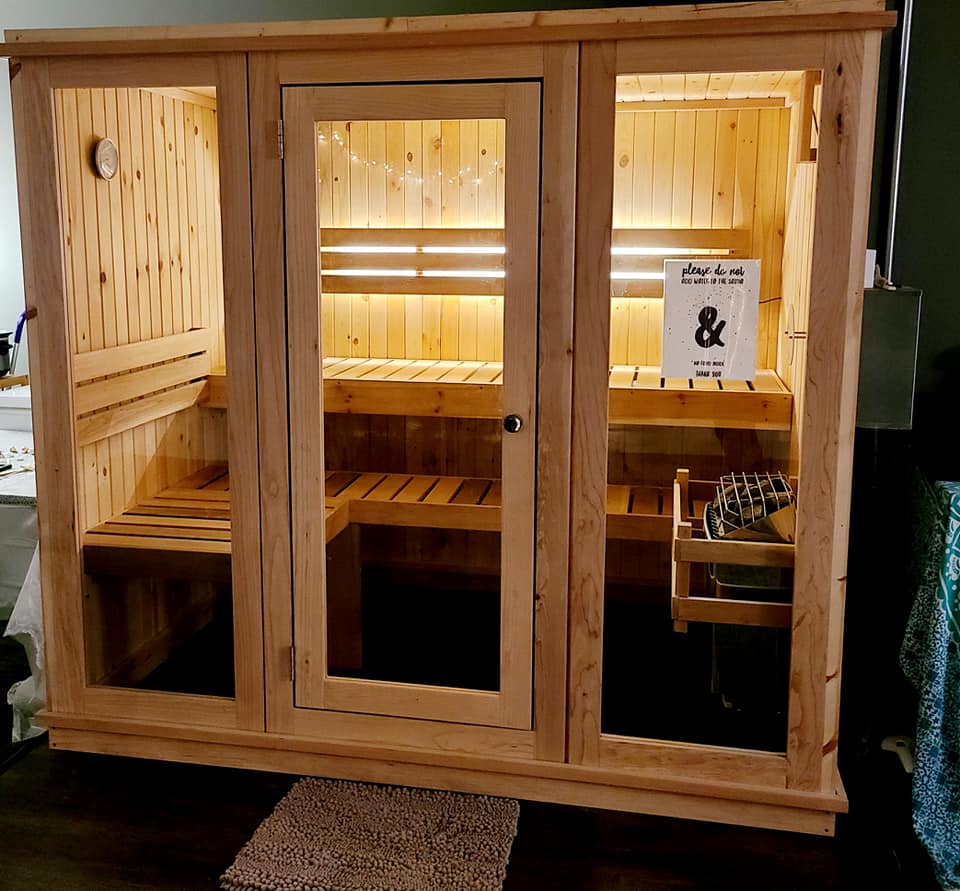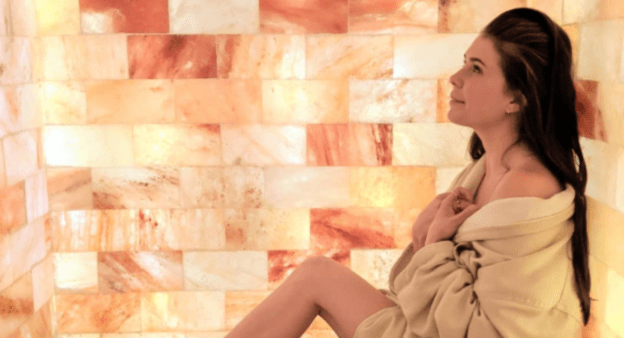What You Need to Know About Salt and Sauna
Saunas have been around for centuries. Various cultures have their own version of what creating a ‘hot space’ can be as an experience. There are traditions in many cultures about saunas as well as many types such as wood burning saunas, smoke saunas, electric and infrared. Finnish saunas are more of a traditional approach.
The purpose of sitting in a sauna is to experience high heat and sweat. The temperature in most traditional saunas range from 80 to 110 °C (176 to 230 °F) and a session is between 20-30 minutes. Infrared wavelengths heat differently and range in temperature between 43 to 54 °C (110 and 130 °F). Sessions are also around 20 minutes to much longer sessions. Many saunas need time to preheat to the desired temperature.
Sweating out toxins is the main benefit of being in a sauna. There are claims that saunas provide detoxification, increased blood circulation, and improved cardiovascular function. While bacteria thrive in warm and moist spaces, cleaning after every use is recommended.
Himalayan Salt Sauna and Décor
Aside from a halogenerator, you can incorporate more Himalayan salt into your sauna by adding salt decor. Many saunas are being designed with Himalayan salt bricks, tiles, and panels as architectural and décor elements. Most of these are backlighted with LED lights creating an amber glow that is very relaxing. However, there are no inherent respiratory benefits from the Himalayan salt décor.
There are many unsubstantiated claims as well as false information stating that heating Himalayan salt releases negative ions and purifies the air. This has been scientifically proven false with facts provided by leading chemists, researchers, and institutions like Columbia University Medical Center as well as through class action lawsuits against Himalayan salt manufacturers and suppliers.
In addition, depending on where the Himalayan salt is installed, it can deteriorate by direct contact with moisture. In traditional saunas, you want to avoid having water splashed on it. You also do not want guests leaning against or having sweat in direct contact with the salt which would cause deterioration. While many may refer to it as a Himalayan Salt Sauna, facilities should especially take notice as to making any benefit claims to their guests, since this could end up as a liability.
Himalayan salt decor can include everything from wall treatments to flooring. Popular salt decor items are:
- Himalayan Floor Salt: While some spas use normal table salt or sea salt to create a cave-like environment, SALT Chamber helps you take your treatment room to the next level. Even our floors contribute to a therapeutic environment by using Himalayan salt instead of table or sea salt.
- Himalayan Salt Panels: Custom, hand-crafted panels are molded from pure Himalayan salt and contain no VOCs, toxic materials, or unpleasant smells. SALT Chamber’s salt panels are easy to install, take down, and rearrange.
- Himalayan Salt Bricks and Tiles: Available in a wide range of sizes, SALT Chamber’s Himalayan salt bricks are structurally sound and compliant with architectural standards. They can have a smooth or rough-cut, depending on the style of your therapy room.
- Himalayan Salt Rocks, Boulders, and Caves: SALT Chamber helps you build a unique salt therapy cave so your clients can enjoy an unforgettable experience.

What is Dry Salt Therapy (Halotherapy)?
Dry salt therapy (halotherapy) is a modality that is not affected by temperature; however, it does need to be provided in a dry environment without any moisture or humidity. A professional device called a halogenerator is utilized which is outside of the salt environment and mounted on the adjacent wall of a room or a SALT Booth® or a cabin such as a sauna. The halogenerator intakes the surrounding conditioned air and grinds the pure-grade sodium chloride into a micron-sized dry salt aerosol. Guests just relax and breathe normally as the dry salt particles are inhaled deep into the respiratory system. Halotherapy relieves respiratory conditions, enhances lung function, accelerates recovery, and strengthens the immune system.
In addition, the dry salt particles are so small that they penetrate the skin’s surface and can reduce inflammation that affects people with skin conditions such as psoriasis and eczema.
The length of a salt session is determined by the cubic volume of air space in the enclosed chamber. A large room up to 450 sq ft would be a 45-minute session and a standard treatment/massage room would be about 25 minutes. There are SALT Booths® for individuals that would be 10 minutes.
The Salt Therapy Association has developed standards for halotherapy which include: a halogenerator producing pure-grade dry salt particles at 5 microns and preferably less in a ventilated enclosed environment. If there is no halogenerator there is no halotherapy, regardless of the décor. There are some products that refer to being halogenerator, for example, there is a device that emits a moist salt brine or saline solution into the air which is not wet salt therapy and clearly not dry salt therapy which is what a halogenerator and halotherapy represent.
Salt Therapy and Sauna Together?
Combining the two modalities at the same time has not been researched. There is no current evidence that combining the two treatments enhances efficacy. In fact, combining the two may be counter-effective since sweating introduces wet moisture and creates humidity in the environment, especially in a small space like a sauna. The dry salt particles will also not penetrate the skin’s surface and will attach to the sweat and form a crusty surface. Therefore, there would be no skin benefits from the treatment.
Many saunas include an option for aromatherapy, which is introducing an oil-based liquid mist into the environment. The mist settles and can be absorbed in the sauna’s wood surface, which can cause a smell to linger in the environment. Many people who are doing halotherapy treatments have allergies, asthma, and other respiratory issues and the residual smells could cause reactions.
Depending on the type of sauna and the type of electronics inside, introducing micron-sized salt particles into a commercial sauna could be damaging. Traditional saunas that have heaters would be exposed to these micron-sized salt particles. While some may cover the heaters like an outdoor grill, nevertheless, the salt dust will get everywhere. Depending on the type of infrared panels and systems, they too run the risk of being damaged. There may be other electronics inside such as audio and other control panels to consider. Check with the sauna manufacturer warranty regarding covering salt therapy.
There are many facilities and residences that have retrofitted or repurposed a sauna into a dry salt therapy environment with a halogenerator, but it was not being used as a sauna.
Either/Or vs. And (Increasing Your Profits with Salt Therapy and Sauna)
In instances where you are not doing both modalities at once and you are utilizing the equipment as either a sauna OR a salt session, this could be a possibility. You need to ensure that the dry salt particles would not be damaging, and that proper ventilation would occur utilizing a professional quality halogenerator.
From a business model perspective, it may be attractive to purchase a device that can be used for two distinct modalities and therefore save money and potential floor space. You want to compare the cost between that and a dedicated sauna and a dedicated salt chamber. Keep in mind that most saunas have special electrical and higher amperage requirements and higher consumption. A commercial halogenerator is a regular 110, with low power consumption.
In terms of a return on investment, you want to compare space utilization and capacity. A typical sauna session is 20-30 minutes compared to a 10-minute salt session in a dedicated SALT Booth®. Most retail establishments that offer saunas schedule these timed sessions along with cleaning time in between sessions to be at least 2 sessions an hour at most. A SALT Booth® can have 4 10-minute sessions with time between as well.
As a business, you determine how many hours you are open, and based on that you can determine capacity. Most facilities are open 60-80+ hours a week. If you were open 60 hours a week you would have 2 sessions per hour for sauna utilization, your capacity is 120 sessions (but that is the maximum and does not include some downtime or last session adjustments).
For a SALT Booth®, you would have 4 sessions per hour times the 60 hours = 240 sessions.
While you are never at full capacity, you can see that if you had both modalities as distinct experiences, you would go from 120 sessions in a dedicated sauna a week PLUS 240 sessions in a dedicated SALT Booth® for a total now of 360 sessions to sell and utilize. That’s at least doubling your business and sources of revenue.
You also have more schedule flexibility with having two distinct modalities, especially with facilities that have various experiences that their guests can easily go from one to another without extensive waiting. It also increases your ability to market to different audiences and cross-market the modalities.
Breathing and Sweating Salt?
Clearly, inhaling dry salt particles have tremendous respiratory, skin, and mental wellness benefits. Saunas have been around for centuries and have been a staple for sweating toxins and having people feel better. People should do both but not together.
Adding Himalayan salt as décor is a great enhancement to the sauna experience but décor adds no health benefits. Dry salt therapy (halotherapy) is an evidence-based modality that provides great benefits to a broad spectrum of customers. Keeping the integrity of the two modalities distinct from a health and wellness perspective makes sense.
And it makes sense from a business model perspective. Always do your best to understand the market, the integrity, and the quality of the equipment, and ask questions.
SALT Chamber is the industry leader in salt therapy products, equipment, and decor. If you’re interested in expanding your spa or health and wellness facility or opening your own salt therapy business, contact us today for a risk-free custom quote and to download our 32-page price guide magazine.
Photo Credit: The Ritz-Carlton Charlotte, Moxy Fitness





